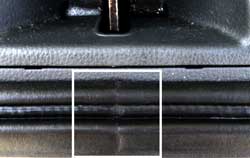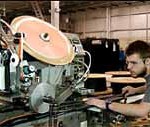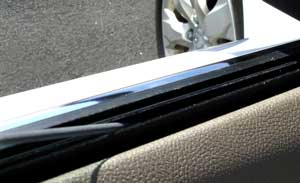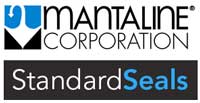Off-line Processes
 Splicing
Splicing
Rubber extrusions, such as large gaskets, are often joined at the ends to produce a ring or circle. With this splicing technique, we place the two ends (slightly apart from each other) of the finished extrusion in a small injection molding press, close the die, and inject the uncured rubber into the die cavity that is already at the curing temperature of the rubber. The curing rubber bonds to the ends of the extrusion, creating a circle and forming the gasket.
We often refine this process to create square corners and other ‘molded features’ that combine to make an extrusion useful in the application for which it is designed.
Less sophisticated ‘cold splicing’ or ‘bonding’ techniques can also be employed to affect the same solution. These alternatives usually sacrifice esthetics and strength for lower tooling costs.
Splicing can enhance the functionality of almost any extrusion: rubber, thermoplastic or silicone.
Cutting
Our automated in-line cutting machinery can be used on projects with extrudite cross-sections as large as 2 1/2-inch diameter and can produce cut lengths as short as two inches. This is, of course, dependent on the compound used, tolerances required, and other variables.
Printing
Printing part numbers and other important data directly on the part is a capability many customers want us to perform. This can be done in-line or off-line through a variety of techniques including paint printing, laser printing and bar-coding.
Coating (Low Friction)
Our specialized coatings, applied in-line or off-line, help improve the functionality of an extrusion. The use of specialized coatings enhances the ‘freeze release’ capabilities of the extrusion; for example, car or truck door and window seals, which, in return, reduces friction or removes any tendencies for the extrusion to add to the noise and vibration characteristics of the product on which it is installed.
 Taping
Taping
Mantaline provides a wide range of pressure sensitive (PSA) and heat activated (HAT) tapes. To optimize costs, many of these tapes can be applied in-line: extrudite passes a primer station where primer is applied and dried then the tape is laid down on the passing product.
In cases where the product base material is sponge rubber – which shrinks appreciably over the first seventy-two hours after it is produced – tape can be applied off-line.
In taping silicone products, we use our own primer (produced in-house) prior to applying pressure-sensitive tape to the silicone rubber base product.
Notching
Notching sections out of an extrusion, enabling it to conform to the intended application, is usually an off-line product enhancement. Parts, cut-to-length, are placed in a notching press where dies designed to impart the specific features intended, cut into the part and create the intended result.
Punching
Punching holes and imparting other desired alterations to basic extrusions is also done in presses and usually done off-line. Parts, cut-to-length, are placed in a punch press where dies, designed to impart the specific features intended, cut into the part and create the intended result.
Flocking
Flocking is a process wherein short monofilament fibers of nylon or polyester, usually 0.5 to 0.7 mm long, are directly applied to a base material previously coated with adhesive. The fibers are electrostatically charged to orient them in a ‘standing position’. The substrate is heated to drive off the adhesive solvents, permitting the adhesive to cure and the fibers to lock in place in the standing position.
 While flocking is used everywhere from wallpaper to t-shirts, the industrial applications (which concern us) are focused on vehicle window applications. In these situations, flocking is used on the sealing surfaces against which the glass travels up and down. Flocking serves to assist in sealing but more importantly, provides a ‘non-scratch’ surface that the glass can ride upon. In addition, the flock ‘brushes’ dirt and debris off the glass while it travels, offering added protection to the ‘glass run’ system and adds to the smooth, quiet operation of the window system.
While flocking is used everywhere from wallpaper to t-shirts, the industrial applications (which concern us) are focused on vehicle window applications. In these situations, flocking is used on the sealing surfaces against which the glass travels up and down. Flocking serves to assist in sealing but more importantly, provides a ‘non-scratch’ surface that the glass can ride upon. In addition, the flock ‘brushes’ dirt and debris off the glass while it travels, offering added protection to the ‘glass run’ system and adds to the smooth, quiet operation of the window system.



